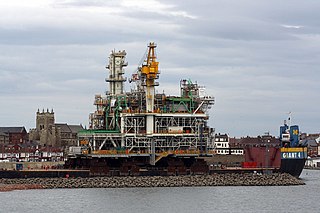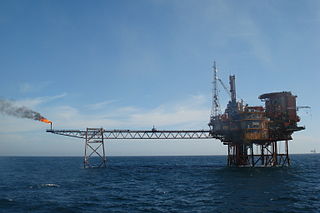Related Research Articles

The Brent field was an oil and gas field located in the East Shetland Basin of the North Sea, 186 kilometres (116 mi) north-east of Lerwick in the Shetland Islands, Scotland, at the water depth of 140 metres (460 ft). The field operated by Shell UK Limited was discovered in 1971 and was once one of the most productive parts of the UK's offshore assets but has reached the stage where production is no longer economically viable. Decommissioning of the Brent field is complete with the exception of Brent C, which is producing from another field. The discovery well 211/26-1 was drilled in 1971 by the semi-submersible drilling rig "Staflo". This was a major surprise at the time as the nearest land in Scotland and Norway is composed of granite and other non reservoir metamorphic rocks.
The Brae field is a Scottish oil field. The name comes from a Scots language word for hillside. The field was discovered in 1974 by well 16/7-1 drilled by a semi-submersible rig Odin Drill for operator Pan Ocean.

The Piper oilfield is a substantial North Sea oilfield covering 30.1 km2. It lies roughly halfway between Aberdeen and Bergen, at the eastern end of the Moray Firth basin. Oil extracted from it is piped to Scotland, where it is stabilised at an oil plant on the island of Flotta, in the Orkney archipelago, while gas is shipped via the Frigg gas pipeline. In June 1975, the Piper Alpha oil platform was placed over the field in 144 metres of water, secured in place by 24 piles extending 116 metres beneath the seabed. The platform was designed for simultaneous drilling and production. Piper Alpha was the site of one of the world's worst oil platform disasters when it was destroyed by an explosion in 1988, with the loss of 167 lives. Piper Bravo was installed in 1992. Talisman Energy acquired a controlling interest in 2000.
The Dunlin oilfield is situated 195 km northeast of Lerwick, Shetland, Scotland, in block number 211/23a and 211/24a. It was originally operated by Shell but was sold in 2008 and is now operated by Fairfield Energy and partners MCX.
The Brent System pipeline transports oil from the North Sea oilfields via Cormorant Alpha to the Sullom Voe Terminal in Shetland, Scotland. Since 3 August 2009, it is operated by Abu Dhabi National Energy Company replacing the previous operator Royal Dutch Shell. The Brent system is jointly owned by 21 companies.
Platform Name - Tern Alpha.
The Ninian Central Platform is an oil platform in the North Sea. When constructed in Loch Kishorn, Scotland in 1978 the 600,000 tonne platform was the world's largest man-made movable object before being towed to its current position and sunk to the sea floor.
The Clair oilfield is an offshore oil field in Scottish territorial waters 75 kilometres (47 mi) west of Shetland in water depths of up to 140 metres (460 ft). The field is the largest oilfield on the UK Continental Shelf with an estimated 8 billion barrels of oil-in-place, according to the BP Plc’s website. It extends over an area of some 220 square kilometres (85 sq mi), covering five licence blocks.
Azeri–Chirag–Gunashli or Azeri–Chirag–Deepwater Gunashli is a complex of oil fields in the Caspian Sea, about 120 kilometres (75 mi) off the coast of Azerbaijan. It consists of the Azeri and Chirag oil fields, and the deepwater portion of the Gunashli oil field. An overall estimate of the area of the development is 432.4 square kilometres (167.0 sq mi). It is developed by the Azerbaijan International Operating Company, a consortium of international oil companies, and operated by BP on behalf of the consortium. The ACG fields have estimated recoverable reserves of about 5 to 6 billion barrels of petroleum. Peak oil production of 835,000 barrels per day (132,800 m3/d) was reached in 2010, however by the first quarter of 2022 production had declined to 434,000 barrels per day (69,000 m3/d), or about one-half of peak value. As of 2021, ACG oil accounted for 95% of all Azerbaijani oil exports.

Valhall is an oil field in the Norwegian sector of the North Sea. Discovered in 1975, production began in 1982 and is expected to continue until 2050. Valhall is located in 70 metres of water. It produces from chalk in the Tor and Hod Formations of Late Cretaceous age. The reservoir depth is approximately 2 400 metres.

The Forties Oil Field is the second largest oil field in the North Sea, after the Clair oil field, which is located 110 miles east of Aberdeen. It was discovered in 1970 and first produced oil in 1975 under ownership of British Petroleum, now called BP.

The Bouri Offshore Field is part of Block NC-41, which is located 120 kilometers (75 mi) north of the Libyan coast in the Mediterranean Sea. It was first discovered in 1976 at a depth of 8,700 feet (2,700 m) and is estimated to contain 4.5 billion barrels (720,000,000 m3) in proven recoverable crude oil reserves and 3.5 trillion cubic feet (99 km3) of associated natural gas with an annual production potential of 6 billion m³. Bouri is considered the largest producing oilfield in the Mediterranean.

The Douglas Complex is a 54-metre (177 ft) high system of three linked platforms in the Irish Sea, 24 kilometres (15 mi) off the North Wales coast. The Douglas oil field was discovered in 1990, and production commenced in 1996. Now operated by Eni, the complex consists of the wellhead platform, which drills into the seabed, a processing platform, which separates oil, gas and water, and thirdly an accommodation platform, which is composed of living quarters for the crew. This accommodation module was formerly the Morecambe Flame jack-up drilling rig.

The Sullom Voe Terminal is an oil and gas terminal at Sullom Voe in the Shetland Islands of Scotland. It handles production from oilfields in the North Sea and East Shetland Basin and stores oil before it is transported by tanker.
The Magnus oilfield is a large oilfield in the United Kingdom's zone of North Sea. It is located 160 kilometres (99 mi) north-east of the Shetland Islands. The field is located mainly in Block 211/12a. Resources are estimated to total 1.54 billion barrels of oil, of which 869 million barrels are recoverable reserves.

EnQuest plc is an independent United Kingdom-based petroleum exploration and production company which operates mainly in the United Kingdom Continental Shelf. EnQuest shares are included on the main list of the London Stock Exchange and the firm holds a secondary listing on Nasdaq OMX Stockholm.

The Buzzard Oil Field is an oil field located in the North Sea Blocks 19/10, 19/5a, 20/6 and 20/1s. It was discovered in 2001 by PanCanadian, and developed initially by PanCanadian's successor EnCana and then by Nexen. The oil field was initially operated and owned by Nexen which is now a subsidiary of China's CNOOC.

The Murchison oil field is located in the northern North Sea in the East Shetland Basin on the UK Continental Shelf. The field is situated 150 km north-east of Shetland and straddles the UK/Norwegian median line. It lies in UK Block 211/19 and extends into Norwegian Block 33/9. The field is named after the Scottish geologist Sir Roderick Impey Murchison (1792–1871). Recoverable reserves were estimated to be 340 million barrels of oil out of a total oil-in-place of 790 million barrels. The field was developed through a large steel jacket platform standing in 156 m of water. The peak production rate was 150,383 barrels of oil per day in December 1982. Oil production was supported by gas and water injection. Production ceased in 2014 and the platform was removed in 2017.

The Montrose oil field is a significant crude oil producing field in the UK sector of the central North Sea, 210 km east of Aberdeen. Production of oil started in 1976 and a major upgrade in 2016 extended the field life to beyond 2030.
The Heather oil field is a significant crude oil producing field in the UK sector of the northern North Sea, 458 km north-north-east of Aberdeen. Production of oil started in 1978 and ceased in 2019. The Heather Alpha installation is currently (2021) undergoing decommissioning.
References
- ↑ Department of Trade and Industry, North Sea Oil and Gas: A Report to Parliament, 1973, p. 2.
- ↑ Department of Trade and Industry (1994). The Energy Report. London: HMSO. pp. 90, 142. ISBN 0115153802.
- ↑ Gluyas, Jon G.; Hichens, H. M. (2003). United Kingdom Oil and Gas Fields: Commemorative Millennium Volume. Geological Society. ISBN 9781862390898.
- ↑ Gluyas, Jon G.; Hichens, H. M. (2003). United Kingdom Oil and Gas Fields: Commemorative Millennium Volume. Geological Society. ISBN 9781862390898.
- ↑ [ dead link ]
- ↑ http://www.enquest.com/thistle-alpha-20121217.pdf%5B%5D
- ↑ harding internet – www.harding.co.uk. "Able UK Ltd – Photos". Ableuk.com. Archived from the original on 14 January 2013. Retrieved 9 January 2013.
- ↑ "Samples". McMillan Engineers. Archived from the original on 17 October 2013. Retrieved 9 January 2013.
- ↑ Sorrell, Steve; Miller, Richard; Bentley, Roger; Speirs, Jamie (14 May 2010). "Energy Policy – Oil futures: A comparison of global supply forecasts". Energy Policy. 38 (9): 4990–5003. doi:10.1016/j.enpol.2010.04.020.
- ↑ "Lundin Petroleum recommences production on Thistle". Lundin-petroleum.com. Retrieved 9 January 2013.
- ↑ "Share Fair for iPad – 1.1 / iOS". FileDir.com. Archived from the original on 16 February 2013. Retrieved 9 January 2013.
- ↑ Editor on 1 (19 September 2012). "Fabricom awarded £1 million contract by EnQuest". Ogssn.com. Retrieved 9 January 2013.
{{cite web}}:|author=has generic name (help)[ permanent dead link ] - ↑ "Media – Press releases". EnQuest. Archived from the original on 30 December 2012. Retrieved 9 January 2013.
- ↑ "P&J Energy | Log in to Energy". Pandjenergy.co.uk. 5 July 2010. Retrieved 9 January 2013.
- ↑ "P&J Energy | Enquest sets new safety record". Pandjenergy.co.uk. 23 September 2011. Retrieved 9 January 2013.
- ↑ "Archived copy" (PDF). Archived from the original (PDF) on 18 March 2014. Retrieved 23 December 2012.
{{cite web}}: CS1 maint: archived copy as title (link) - ↑ "Workers evacuated from North Sea platform off Shetland". BBC News. 22 October 2019.
- 1 2 "EnQuest hands in decom plan for Thistle Alpha topsides". offshore-energy.biz. 22 September 2021. Retrieved 18 October 2021.